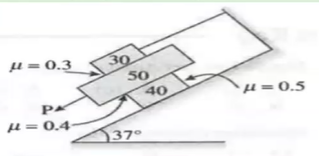The three flat blocks in the figure are positioned on the 30∘ incline and a force parallel to the inclined plane is applied to the middle block . The upper block is prevented from moving by a wire which attaches it to the fixed support . The coefficient of static friction for each of the three pairs of contact surfaces is shwon in the figure . Determine the maximum value which P may have before any slipping takes place .

The correct Answer is:P =93.8 N

F.B.D of m2
P+M2gsinθ=μ1N1+μ2N2
PM2gsinθ=μ1M1gcosθ+μ2 g cosθ(M1+M2)
By solving this equation , we get value of P .

Topper's Solved these Questions
- FRICTION AND CIRCULAR MOTION BOOK - GRB PUBLICATIONCHAPTER - FRICTION AND CIRCULAR MOTION EXERCISE - OBJECTIVE QUESTIONS ( only one choice is correct )
80 Videos
- FRICTION AND CIRCULAR MOTION BOOK - GRB PUBLICATIONCHAPTER - FRICTION AND CIRCULAR MOTION EXERCISE - More than one correct
18 Videos
- FRICTION AND CIRCULAR MOTION BOOK - GRB PUBLICATIONCHAPTER - FRICTION AND CIRCULAR MOTION EXERCISE - Comprehension type
11 Videos
- FORCE AND NEWTONS LAWS OF MOTIONBOOK - GRB PUBLICATIONCHAPTER - FORCE AND NEWTONS LAWS OF MOTIONEXERCISE - Comprehension
12 Videos
- MOTION IN A STRAIGHT LINEBOOK - GRB PUBLICATIONCHAPTER - MOTION IN A STRAIGHT LINEEXERCISE - Comprehension type Queston
14 Videos
Similar Questions

The three flat blockss in the figure are positioned on the 37∘ incline and a force parallel to the inclined plane is applied to the middle blocks. The upper blocks is prevented from moving by a wire which attaches it to the fixed support. The masses of three blocks in kg and coefficient of static friction for each of the three pairs of contact surfaces is shoen in the figure. Determine the maximum value which force P may have before slipping take place anywhere.
View Solution
The three flat blacks in the figure are positioned on the 37%∘ incline and a force parallel to the inclined plane is applied to the middle blocks. The upper blocks is prevented from moving by a wire which attaches it to the fixed support. The masses of three blocks in kg and coefficient of static friction for each of the three pairs of contact surfaces is shoen in the figure. Determine the maximum value which force P may have before slipping take place anywhere.
View Solution
Knowledge Check
A block is placed on an inclined plane. The angle of inclination of the plane is such that the block slides down the plane at a constant speed. The coefficient of kinetic friction is
AsinθBcosθCcotθDtanθA block of mass mm remains stationary on a fixed inclined plane of inclination θ . If μ= coefficient of static friction the reaction of ground on the block is:
AμgcosθBmgcosθCmgsinθDmg↓A block of mass 2kg rests on a rough inclined plane making an angle of 30∘ with the horizontal. The coefficient of static friction between the block and the plane is 0.7. The frictional force on the block is
A10.3NB23.8NC11.9ND6.3N

The three flat blacks in the figure are positioned on the 37 degree incline and a force parallel to the inclined plane is applied to the middle blocks. The upper blocks is prevented from moving by a wire which attaches it to the fixed support. The masses of three blocks in kg and coefficient of static friction for each of the three pairs of contact surfaces is shoen in the figure. Determine the maximum value which force P may have before slipping take place anywhere.
View SolutionThe coefficient of friction between the block and the inclined plane is μ.
View SolutionA block of mass 2kg rests on a rough inclined plane making an angle of 30∘ with the horizontal. The coefficient of static friction between the block and the plane is 0.7. The frictional force on the block is
View SolutionA block of mass 5 kg is at rest on a rough inclined surface. If angle of inclination of plane is 60∘, then force applied by it on block is
View SolutionA block of mass 2kg rests on a rough inclined plane making an angle of 30∘ with the horizontal. The coefficient of static friction between the block and the plane is 0.7. The frictional force on the block is
View Solution
